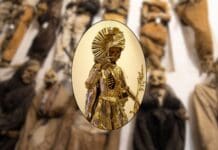Nestled in the medieval town of Bruges, Belgium, the Basilica of the Holy Blood stands as a testament to both architectural splendor and profound religious significance.
This 12th-century chapel, originally the Counts of Flanders’ private chapel, now attracts many pilgrims worldwide, drawn by its claim to house a vial containing a cloth stained with Christ’s blood!
The lower chapel, dedicated to Saint Basil and built in the Romanesque style, remains a pristine example of Catholic architectural heritage. However, it’s the upper chapel, the Chapel of the Holy Blood, that holds the most intriguing mystery. Rebuilt in the Gothic style by the end of the 15th century, it houses the renowned relic: a rock crystal vial, encased in a gold cylinder adorned with angelic coronets, said to contain the Holy Blood of Jesus Christ.
The story of this relic is as captivating as it is ancient.
Pious legend has it that during the Second Crusade in the 12th century, the then Count of Flanders, Thierry of Alsace, received this sacred relic from Baldwin III, King of Jerusalem, as a token of gratitude for his bravery. It’s believed that Joseph of Arimathea originally collected this blood after washing Christ’s body post-crucifixion.
However, some historical records suggest a different origin, possibly during the sacking of Constantinople in 1204, when many relics found their way to Europe.
Despite the debates, the relic’s significance remains undiminished. It’s not just an artifact but a centerpiece in the religious life of Bruges, with the annual Procession of the Holy Blood, a UNESCO-listed event, drawing thousands yearly to witness this sacred relic’s journey through the city streets.
When pilgrims step into this historical basilica, the question lingers, “Could the blood of Christ really be in this Belgian cathedral?” Although there is no definitive evidence for or against the authenticity of the relic, the Basilica of the Holy Blood continues to be a beacon for Catholic piety!
Photo credit: Matt Hopkins, Jim Linwood via Wikimedia Commons


















